If it’s Wednesday, it must be Norcia. We have oft repeated that phrase, or something similar (“if it’s Tuesday, it must be Norcia” for example) during our food and wine tours. Because a trip to Norcia is so worthwhile and because a trip to Norcia requires devoting the better part of a day, it just makes sense.
The other day was, indeed, Wednesday. And so it must have been, and most assuredly was, Norcia. As well as Castelluccio.
Norcia lies about an hour from our villa. But it is more than miles away. It is a world away. To reach Norcia you exit the superstrada just before Spoleto and almost immediately you enter a tunnel, a nearly four mile tunnel through the mountains that not so much transports you from our Val dell’Umbria to the Valnerina as it alters time and place. When you emerge at the other side it is as though you have entered a land that time forgot, the Valnerina, a fresh, clean mountain valley separated from the modern world and living quite happily in its rustic, authentic way of life. Norcia and Castelluccio, fresh, natural, unhurried places seem like the perfect towns in this rather perfect world.
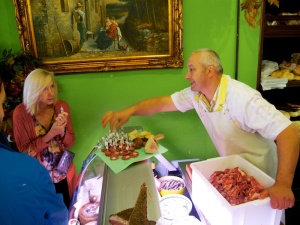 And so it being Wednesday, we opted for this form of time travel, making the drive to Norcia to visit our friend Claudio the butcher for a demonstration of what makes Norcia Norcia. Pork butchery.
And so it being Wednesday, we opted for this form of time travel, making the drive to Norcia to visit our friend Claudio the butcher for a demonstration of what makes Norcia Norcia. Pork butchery.
Norcia is known for two things – the birthplace of St. Benedict (and his equally saintly twin sister, St. Scholastica) and pork butchery. Ok, that may technically be three things. But despite the importance of Benedict to these parts (there is a thriving Benedictine monastery here that among other things makes a pretty good beer) butchery seems to have edged out monasticism as the number one reason to visit (at least according to Richard Dawson). To visit Norcia is to be overwhelmed by butcher shops, with literally every other doorway an homage to swine – sausages and prosciutto hanging from the ceiling, display cases jammed with cuts of meat and white jacketed men and women brandishing blades at the ready. Such was the scene in Claudio’s shop, la Richiamo di Sibilla.
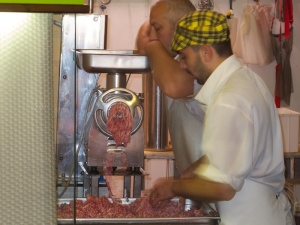 We have been audience to a number of butchery demonstrations put on by Claudio, from the dismantling of an entire half pig to the preparation of a small porchetta. And watching Claudio wield a knife, his squat Popeye arms willing his blade through flesh and bone is a sight to behold. Today’s demonstration, however, was more poetry and less brute force. Today Claudio demonstrated the art of sausage making.
We have been audience to a number of butchery demonstrations put on by Claudio, from the dismantling of an entire half pig to the preparation of a small porchetta. And watching Claudio wield a knife, his squat Popeye arms willing his blade through flesh and bone is a sight to behold. Today’s demonstration, however, was more poetry and less brute force. Today Claudio demonstrated the art of sausage making.
It is said that you should avoid watching sausage being made. Nothing could be 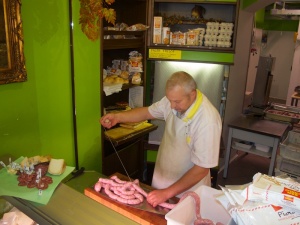 farther from the truth, especially when Claudio gives you the blow by blow. The secret of sausage making, as it pretty much is with any culinary endeavor, is to start with good product. And so Claudio did, heaps of fresh pork, its redness practically glowing as he thrust it down the opening of the shiny meat grinder. In one end as cubes and slices of meat, out the other as wormy strands of ground meat, glistening with white flecks of fat. This ground pork was then seasoned (each butcher has his own special blend) and worked by hand before the casing, here a seemingly never ending gossamer thin strand of pig intestine was inserted over a tube from which the ground pork was extruded into its casing. In just minutes yards of fresh sausage emerged from the shiny stainless machine, with Claudio furiously looping string to tie off each individual sausage from the next, demonstrating various knots like a Boy Scout in search of his merit badge. It is the sort of thing that goes on throughout the day in every butcher shop along Norcia’s main drag, butchers working furiously to keep up with the pace at which the fresh wursts are snapped up by hungry customers. We, too, bought a dozen or so of the sausages we witnessed being birthed, along with some massive bistecca for our farewell dinner Friday night. It promises to be a treat.
farther from the truth, especially when Claudio gives you the blow by blow. The secret of sausage making, as it pretty much is with any culinary endeavor, is to start with good product. And so Claudio did, heaps of fresh pork, its redness practically glowing as he thrust it down the opening of the shiny meat grinder. In one end as cubes and slices of meat, out the other as wormy strands of ground meat, glistening with white flecks of fat. This ground pork was then seasoned (each butcher has his own special blend) and worked by hand before the casing, here a seemingly never ending gossamer thin strand of pig intestine was inserted over a tube from which the ground pork was extruded into its casing. In just minutes yards of fresh sausage emerged from the shiny stainless machine, with Claudio furiously looping string to tie off each individual sausage from the next, demonstrating various knots like a Boy Scout in search of his merit badge. It is the sort of thing that goes on throughout the day in every butcher shop along Norcia’s main drag, butchers working furiously to keep up with the pace at which the fresh wursts are snapped up by hungry customers. We, too, bought a dozen or so of the sausages we witnessed being birthed, along with some massive bistecca for our farewell dinner Friday night. It promises to be a treat.
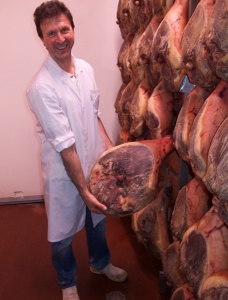 Outside Norcia’s city walls are a number of larger processing houses where sausages, salamis and prosciutto are made, cured and aged. Our next destination, then, was the Patrizi prosciuttificio, a midsized prosciutto processing establishment. Here we met our business associates Corrado and Mauro who introduced us to Patrizi’s owner who led us on a tour and explanation of how prosciutto, the cured hind leg of the pig, is made. For an hour or so we moved from room to room, seeing the initial drying of freshly butchered pork legs, salting, drying and aging. In each room, at each stage of the process, hundreds and in some cases, thousands of legs hung together, going through that particular room’s process together, with just two ingredients added – salt and time. For the art of prosciutto making relies not on high tech or exotic ingredients, just pork, salt and time. Oh yes, and air. For it is the fresh, clean air of the Valnerina that washes and ages and cures the prosciutto of Norcia, which makes it a truly artisanal product.
Outside Norcia’s city walls are a number of larger processing houses where sausages, salamis and prosciutto are made, cured and aged. Our next destination, then, was the Patrizi prosciuttificio, a midsized prosciutto processing establishment. Here we met our business associates Corrado and Mauro who introduced us to Patrizi’s owner who led us on a tour and explanation of how prosciutto, the cured hind leg of the pig, is made. For an hour or so we moved from room to room, seeing the initial drying of freshly butchered pork legs, salting, drying and aging. In each room, at each stage of the process, hundreds and in some cases, thousands of legs hung together, going through that particular room’s process together, with just two ingredients added – salt and time. For the art of prosciutto making relies not on high tech or exotic ingredients, just pork, salt and time. Oh yes, and air. For it is the fresh, clean air of the Valnerina that washes and ages and cures the prosciutto of Norcia, which makes it a truly artisanal product.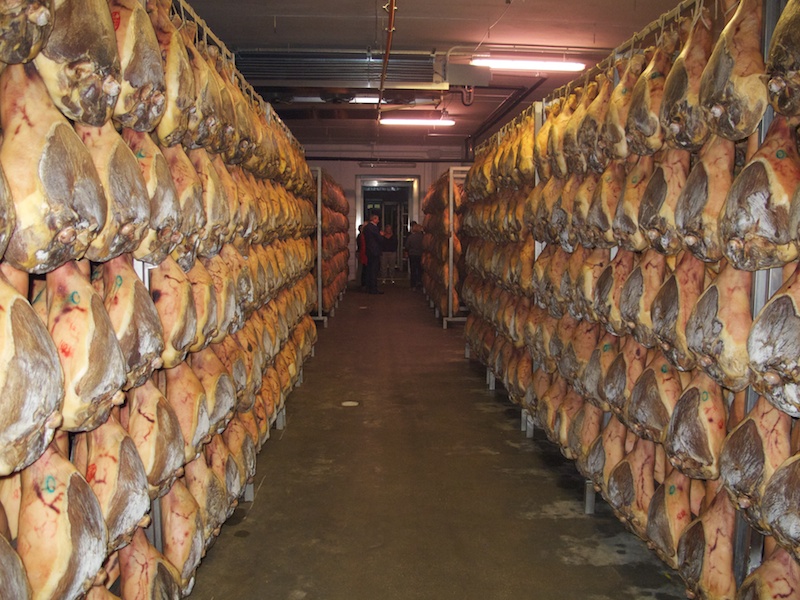
From Patrizi it was time to move on to Castelluccio, a tiny village with a giant reputation. If Norcia is synonymous with pork, Castelluccio is synonymous with lentils. And not just throughout Umbria but throughout Italy. And just possibly, throughout the world. And over lunch an hour later, a simple lunch in a rustic little inn called Locanda di Senari, we enjoyed a lunch of lentils along with platters of sliced salamis from Norcia. But I get ahead of myself.
We visit Norcia and Castelluccio not to learn about pork and to learn about lentils, but to experience them and to feel the importance that they play in this culture that is so different from the culture on the other side of the tunnel. Here on this side pork and lentils are a passion, but they are a passion in a life that is centered on the here. For these isolated people of the Valnerina seem to want nothing more than to rejoice in their isolation, not their separation from the outside world, but the separation of the outside world from their world. And as you approach Castelluccio from Norcia, you can begin to feel why the locals are so content. It is truly a paradise here.
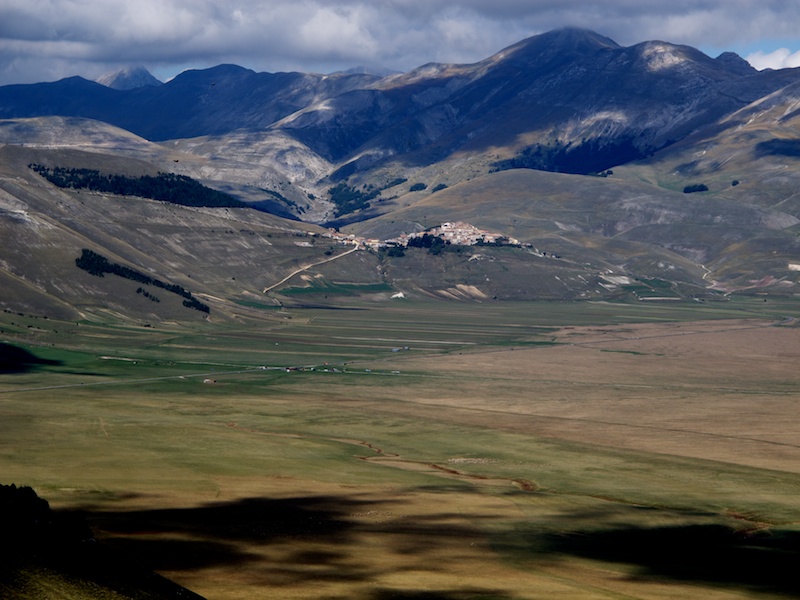 Along the way to Castelluccio we encounter dozens of paragliders who seek to enjoy this paradise from a vantage point above the valley, but as our climb through the mountains reaches its apex and the valley that is home to Castelluccio unfolds below, we realize that wings are not a prerequisite for experiencing the thrill of this place. That first glimpse of the valley, covered by brilliant red and purple wildflowers in the summer, is always a “wow” moment regardless of how many times you experience it. It certainly was for our newly initiated travel companions.
Along the way to Castelluccio we encounter dozens of paragliders who seek to enjoy this paradise from a vantage point above the valley, but as our climb through the mountains reaches its apex and the valley that is home to Castelluccio unfolds below, we realize that wings are not a prerequisite for experiencing the thrill of this place. That first glimpse of the valley, covered by brilliant red and purple wildflowers in the summer, is always a “wow” moment regardless of how many times you experience it. It certainly was for our newly initiated travel companions.
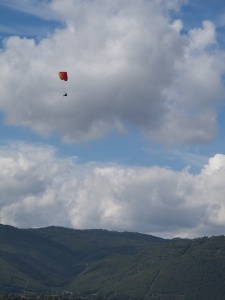 And with the air filled with colorful parachutes and wings the experience is even more fantastical. After a relaxing lunch featuring a bowl of hearty lentil soup, we spend the next several hours hiking the mountain just outside of the village, breathing in the cool crisp air that cleanses our bodies the same way it cleanses and cures the prosciutto in the adjoining valley. It is an enervating, recharging experience.
And with the air filled with colorful parachutes and wings the experience is even more fantastical. After a relaxing lunch featuring a bowl of hearty lentil soup, we spend the next several hours hiking the mountain just outside of the village, breathing in the cool crisp air that cleanses our bodies the same way it cleanses and cures the prosciutto in the adjoining valley. It is an enervating, recharging experience.
After several hours of hiking we say our goodbyes to Castelluccio, the sun now beginning to dip below the horizon. And once again we encounter flocks of paragliders, their colorful wings just barely glinting in the warm golden sunset, augmenting the sense of calm and wellbeing that a day on this side of the tunnel has so completely imbued us with.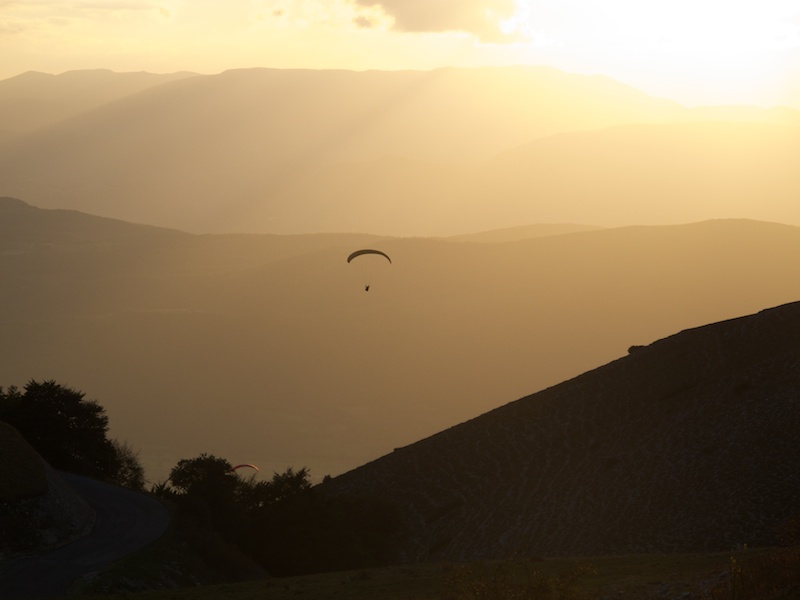
* * *
It is perhaps fitting that our final adventure of the day takes place in the tunnel, as we shed Valnerina and become, once again, Umbrians. As the proverbial light at the end of the tunnel nears (full moonlight at the end of the tunnel, actually) our van begins a hum and a shimmy, as if it is telling us not to go. And then it dawns on us that it is not the van but the rear passenger side tire that is speaking to us, saying “ouch, ouch, ouch, ouch, ouch. Slow down, this stings. I’ve got something stuck in my foot. My rims are killing me.” And so we come to a complete stop, about a kilometer from the end of the four kilometer tunnel the tire completely flat, the pavement burning and rutted from our rim, completely blocking one of the two lanes but unable to drive the extra couple of hundred yards to the emergency pull off. For the next hour we charge about like Keystone Kops, trying to divine the nature of the secret spare tire from this Mercedes van that has clearly been designed by an engineer influenced by renaissance secret keeping that even Dan Brown would be proud of. For nearly an hour we search for secreted tools, jacks and try to unravel the mystery of how to extract the spare tire that is somehow locked to the underside of the body, as if by magnetic levitation or some powerful tractor beam. After a half hour the carabinieri, the national police force (the guys with the machine guns) arrive, relieving Suzy of the duty of waving tractor trailers into the oncoming lane and finally discovering the owner’s manual in plain sight in the glove box. And like all good magic tricks the levitating tire trick is easy to solve, once you see a few diagrams that show you how to crank it down from the underside by simply inserting a little metal rod in an invisible secret hole that is actually a crank for the spare. It kind of reminds one of the Doomsday Device in Dr. Strangelove. It doesn’t do any good if you don’t tell people it is there. A few moments before the tire is actually changed our friend and erstwhile driver Aldo arrives and spirits away our guests, who have now completely forgotten about our flat tire and are instead all atwitter about the nice carabinieri in the tight uniform pants who crawled around on the pavement helping us change the tire (and half expecting them to pull out a boom box and begin a striptease).
Valnerina and the tunnel have lost this battle. But given our memories of this day, they have clearly won the war.
Ci vediamo!
Bill and Suzy




About The Author
Related Posts
Happy new years!
Alternate your late popcorn bowl with antipasti!